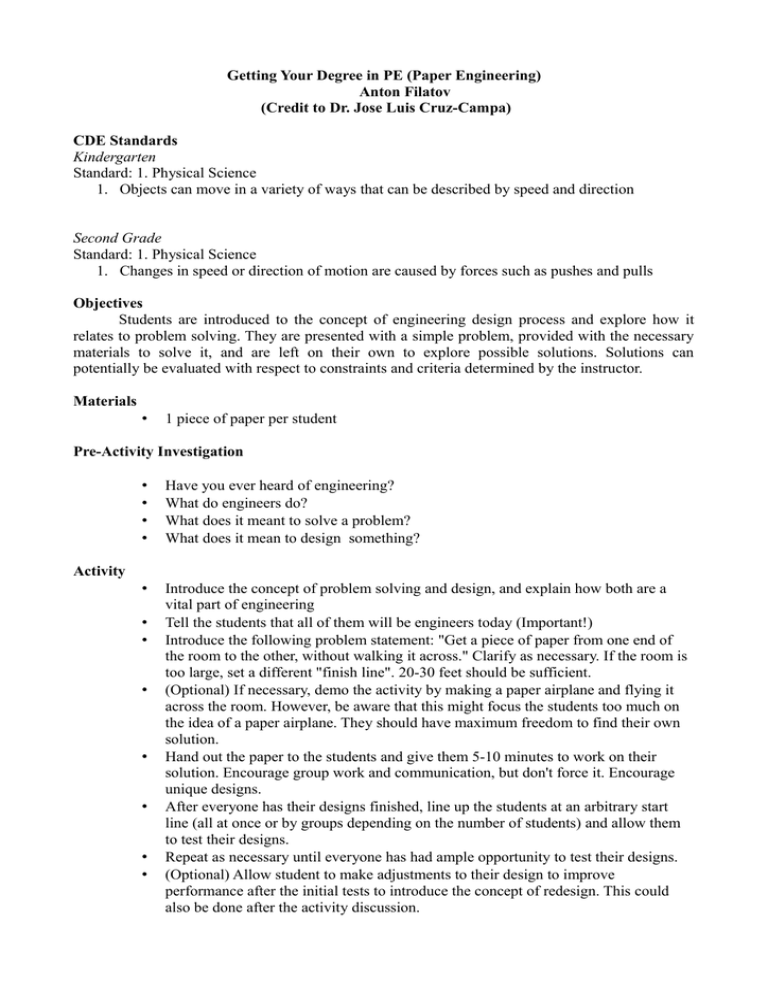Getting Your Degree in PE (Paper Engineering) Anton Filatov CDE Standards
advertisement

Getting Your Degree in PE (Paper Engineering) Anton Filatov (Credit to Dr. Jose Luis Cruz-Campa) CDE Standards Kindergarten Standard: 1. Physical Science 1. Objects can move in a variety of ways that can be described by speed and direction Second Grade Standard: 1. Physical Science 1. Changes in speed or direction of motion are caused by forces such as pushes and pulls Objectives Students are introduced to the concept of engineering design process and explore how it relates to problem solving. They are presented with a simple problem, provided with the necessary materials to solve it, and are left on their own to explore possible solutions. Solutions can potentially be evaluated with respect to constraints and criteria determined by the instructor. Materials • 1 piece of paper per student Pre-Activity Investigation • • • • Have you ever heard of engineering? What do engineers do? What does it meant to solve a problem? What does it mean to design something? • Introduce the concept of problem solving and design, and explain how both are a vital part of engineering Tell the students that all of them will be engineers today (Important!) Introduce the following problem statement: "Get a piece of paper from one end of the room to the other, without walking it across." Clarify as necessary. If the room is too large, set a different "finish line". 20-30 feet should be sufficient. (Optional) If necessary, demo the activity by making a paper airplane and flying it across the room. However, be aware that this might focus the students too much on the idea of a paper airplane. They should have maximum freedom to find their own solution. Hand out the paper to the students and give them 5-10 minutes to work on their solution. Encourage group work and communication, but don't force it. Encourage unique designs. After everyone has their designs finished, line up the students at an arbitrary start line (all at once or by groups depending on the number of students) and allow them to test their designs. Repeat as necessary until everyone has had ample opportunity to test their designs. (Optional) Allow student to make adjustments to their design to improve performance after the initial tests to introduce the concept of redesign. This could also be done after the activity discussion. Activity • • • • • • • Modifications This activity works best with kids in 3rd - 5th grades. However, it can be easily modified to the level of the younger kids. For example, replacing the original open ended question of how to get the piece of paper across the room with a guided paper airplane construction session. Then, after the kids had a chance to test out their airplanes, you could solicit additional recommendations on how to solve the same problem. The main thing to get at is that a single problem could have multiple solutions. Discussion Most likely, students will have come up with several designs. Likely candidates are the paper airplane and the balled up piece of paper. Ask them to compare the two (or more) designs. The votes tend to be split fairly evenly. Take a representative sample of each design concept, and test it again. The success rate should be high. Ask the students if each of the designs solved the problem. Explain to them that according to the intial problem statement, each of the designs that makes it across the room is equally good. Emphasize that a single problem can have many different solutions. Modify the problem statement to favor a particular design (for example, introducing a requirement for ease of construction simplicity will favor the balled up piece of paper). Ask the students to evaluate the designs with respect to the new problem statement. Guide them to understanding that solutions can be evaluated basd on criteria and constraints presented in the problem statement. Repeat as necessary to cover all designs present. Finish up with a brief summary of the design process. Post Activity Evaluation • • • Ask the students to once again describe problem solving and design Emphasize the new elements introduced during the activity (multiple solutions, solution evaluation, redesign, etc.) (Optional) Pose a new, simple problem statement, with criteria and constraints, introduce several solutions, and ask the students to evaluate them.


